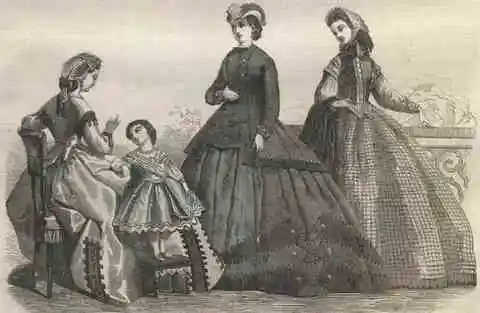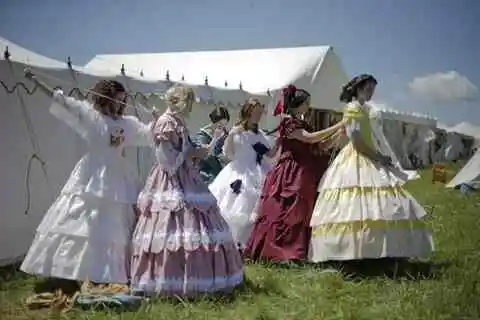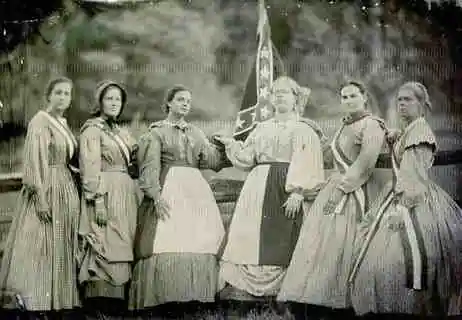The American Civil War (1861–1865) was a pivotal moment in U.S. history, but it was also a time of change in women’s fashion. Though the battlefield was a man’s domain, women at home were undergoing their own transformations—especially in how they dressed.
This article takes you on a journey through women’s fashion in the Civil War, showing how social changes, wartime constraints, and the Victorian-era standards all influenced what women wore. We’ll break down key aspects of clothing from fabrics and accessories to the specific garments that defined this era. You’ll also learn how women used fashion to adapt to a rapidly changing world while remaining stylish.

The Impact of the Civil War on Women’s Fashion
When the Civil War broke out, women’s fashion in the United States was highly influenced by European trends, especially from France and Britain. However, wartime pressures reshaped the industry. The scarcity of materials, the need for practicality, and social expectations all shaped how women dressed during this period.
Practicality in Wartime Fashion
Though fashion remained elegant, wartime meant that practicality became crucial. Many women found themselves playing new roles—taking over farms, working in factories, and nursing wounded soldiers. This shift meant women required garments that allowed for mobility and functionality. Dresses became simpler in design, yet still maintained the hallmarks of Victorian femininity.
This blending of style and function is a defining feature of women’s fashion in the Civil War.
Essential Garments for Women in the Civil War Era
The fashion of the 1860s was characterized by a few key pieces. Each had its own function and cultural significance, and these garments were worn by both wealthy and working-class women, though the materials and details varied significantly.
1. Corsets: The Backbone of Women’s Fashion in the Civil War
The corset was a staple of women’s fashion in the Civil War and remained a symbol of femininity and social status. Made of whalebone, steel, or stiffened cotton, corsets provided the hourglass shape that was so highly valued at the time. While they may seem impractical by today’s standards, corsets were considered essential for defining a woman’s waist and providing the structural foundation for dresses.
Corsets, however, were often uncomfortable and restrictive, limiting movement—ironic given the wartime need for more practical clothing.
2. Hoop Skirts and Crinolines: Maintaining Elegance in War
Despite the hardships of war, women still adhered to the fashions that emphasized a wide, bell-shaped skirt. Hoop skirts and crinolines made from steel or horsehair were used to give the dress a voluminous look. These skirts often reached extravagant widths, even though they could be cumbersome in smaller spaces.
The wide skirt silhouette reflected the 19th-century ideal of femininity—gentle, nurturing, and delicate—even during war.
3. Dresses and Fabrics: Reflecting Social and Economic Conditions
Before the war, dresses were often made of silk, taffeta, and velvet. However, as the war stretched on and blockades disrupted trade, these luxurious fabrics became harder to come by. Cotton, wool, and linen replaced silks for most women, especially in the South, where Union blockades severely restricted access to high-quality materials.
Dresses were typically full-length, with high necklines and long sleeves. During the day, dresses were more practical and plain, while evening wear featured more intricate detailing such as lace, ribbons, and decorative trim.
The Role of Accessories in Women’s Fashion in the Civil War
Accessories remained an essential part of a woman’s wardrobe, and they signified much about her social standing.
1. Bonnet or Hat: A Wardrobe Essential
No woman in the Civil War era was considered fully dressed without a hat or bonnet. Bonnet styles varied from simple cotton to elaborate silk with ribbons and flowers. Hats were often wide-brimmed and trimmed with feathers or lace, providing both sun protection and a fashion statement.
2. Gloves and Parasols: Maintaining Social Etiquette
Even during wartime, gloves remained an essential accessory for women of means. They were worn at all times, especially when in public. Leather gloves were common for everyday use, while lace gloves were reserved for more formal occasions. Parasols were another popular accessory, protecting women’s skin from the sun while doubling as a fashionable item.
3. Jewelry: A Delicate Matter
Jewelry became more modest during the Civil War. Gold and silver were often melted down to fund the war effort, so women turned to more affordable materials like wood, hair, and jet. Mourning jewelry, made of black jet or onyx, became popular as the war claimed countless lives, adding a somber element to fashion.
Fashion’s Reflection of Social Roles During the Civil War
Women’s fashion in the Civil War wasn’t just about aesthetics—it reflected the shifting roles women played in society. With so many men away at war, women had to assume new responsibilities, from managing businesses to working in hospitals. These changing roles required clothing that offered more practicality, and yet, social norms of the time continued to emphasize women’s duty to remain modest, elegant, and ladylike.
For instance, women working as nurses during the Civil War had their own version of fashion. Nurse uniforms were simple but respectable, consisting of plain dresses and aprons. These uniforms were designed to be practical while maintaining the modesty expected of women at the time.
How the Civil War Influenced Future Fashion Trends
While women’s fashion in the Civil War may seem far removed from today, it set the stage for many future trends. The war’s impact on resources forced designers and manufacturers to be more resourceful, leading to simpler, more streamlined clothing. Moreover, the way women dressed during the Civil War laid the groundwork for future fashion movements that emphasized practicality and function alongside aesthetics.
The rise of ready-made clothing, born from the need to mass-produce military uniforms, eventually revolutionized the fashion industry, making clothing more accessible to everyone, not just the wealthy.

FAQs About Women’s Fashion in the Civil War
- What materials were commonly used for women’s clothing during the Civil War?
- Cotton, wool, and linen became more common as silks and velvets were harder to come by due to wartime shortages.
- Did women wear corsets during the Civil War?
- Yes, corsets were a staple in women’s fashion during this period, helping to create the desired hourglass silhouette.
- How did the Civil War change women’s fashion?
- The war led to simpler designs and more practical garments, as women had to adapt to new roles while dealing with fabric shortages.
- Were hoop skirts worn during the Civil War?
- Yes, hoop skirts were popular, although they could be cumbersome. They were worn to achieve the fashionable wide-skirt silhouette of the time.
Conclusion
Women’s fashion in the Civil War was a unique blend of practicality and elegance, dictated by the realities of war and the strict social norms of the time. While the extravagant skirts, tight corsets, and intricate accessories may seem distant from modern fashion, they highlight an important era where fashion reflected not just style, but the broader cultural shifts happening in the U.S.
From the scarcity of luxurious fabrics to the rise of more practical garments, fashion during the Civil War laid the groundwork for changes in women’s clothing that would unfold over the decades to come.
Read more: womenfashionwear.site

